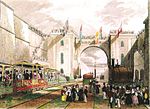Portal:Trains/Selected article/Week 6, 2011
The opening of the Liverpool and Manchester Railway (L&M) took place on 15 September 1830. Work on the L&M had begun in the 1820s, to connect the major industrial city of Manchester with the nearest deep water port at the Port of Liverpool, 35 miles (56 km) away. Arthur Wellesley, Duke of Wellington, the Prime Minister, rode on one of the eight inaugural trains, as did many other dignitaries and notable figures of the day. Huge crowds lined the track at Liverpool to watch the trains depart for Manchester. The trains left Liverpool on time and without any technical problems. The Duke of Wellington's special train ran on one track, and the other seven trains ran on an adjacent and parallel track, sometimes ahead and sometimes behind the Duke's train. At Parkside railway station, near the midpoint of the line, the locomotives made a scheduled stop to take on water. Although the railway staff had advised passengers to remain on the trains while this took place, around 50 of the dignitaries on board alighted when the Duke of Wellington's special train stopped. One of those who got off was William Huskisson, former cabinet minister and Member of Parliament for Liverpool. Huskisson approached the Duke's railway carriage and shook his hand. Distracted by the Duke, he did not notice an approaching locomotive on the adjacent track, Rocket. On realising it was approaching he panicked and fell onto the tracks in front of the train, suffering serious leg injuries and dying later that night. By the time the trains reached the outskirts of Manchester the crowd gathered there had become hostile and was spilling onto the tracks. With local authorities unable to clear the tracks, the trains were obliged to drive at low speed into the crowd, using their own momentum to push people out of the way. Eventually they arrived at Liverpool Road railway station in Manchester to be met by a hostile crowd, who waved banners and flags against the Duke and pelted him with vegetables. Wellington refused to get off the train, and ordered that the trains return to Liverpool. The death and funeral of William Huskisson caused the opening of the railway to be widely reported. The L&M became extremely successful, and within a month of its opening plans were put forward to connect Liverpool and Manchester with the other major cities of England. Within ten years, 1,775 miles (2,857 km) of railways had been built in Britain, and within 20 years of the L&M's opening over 6,200 miles (10,000 km) were in place. The L&M remains in operation, and its opening is now considered the start of the age of mechanised transport; in the words of industrialist and former British Rail chairman Peter Parker, "the world is a branch line of the pioneering Liverpool–Manchester run".
Recently selected: Tennessee Coal, Iron and Railroad Company - Ekeberg Line - Bramhope Tunnel

